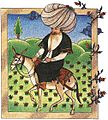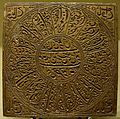Sufism facts for kids


Sufism (also called Tassawuf) is a special way of practicing Islam. It focuses on a deep, personal connection with God. People who follow Sufism are called Sufis, Dervishes, or Fakirs. They seek to understand God's love and presence in their daily lives.
Contents
What Is Sufism?
Sufism is like a spiritual journey within Islam. It helps people feel closer to Allah, which is the Arabic word for God. Sufis believe that by focusing on their inner selves and being humble, they can experience a special connection with the Divine.
How Sufism Started
Sufism began as a way for Muslims to make their faith more personal. Some believe it grew from people often reciting the Qur'an (Islam's holy book) and meditating. Others think it came from trying to live exactly like the Holy Prophet Muhammad, who taught his followers about a deep connection with God.
When Muslims expanded their lands, they met many Christian monks and hermits, especially in Syria and Egypt. These monks lived very spiritual and mystical lives. Some of their peaceful practices and ways of thinking became part of early Sufi traditions.
Early Sufi teachers wrote down their ideas. Important writers included Uwais al-Qarni and Hasan Basri. Rabia Basri was a famous Sufi woman known for her beautiful poetry about her love for God. Bayazid Bastami was one of the first to explain Sufi ideas in detail.
Over time, Sufi teachers started formal schools or groups called Tariqahs. These groups helped people learn and practice Sufism together. Almost all Sufi groups today can trace their teachings back to Prophet Muhammad through these early Tariqahs.
Core Ideas of Sufism
A main idea in Sufism is that people can gain a special, personal understanding of God. To do this, Sufis believe you need to let go of your ego or self-importance. This is called fanaa, which means "annihilation" or "destroying" your selfish desires.
Sufis practice humility and try to control their desires. They also say special prayers that differ among the various Sufi groups.
After achieving fanaa, a Sufi is said to be "reborn" to live for God. This state is called baqaa, meaning "permanency." In this stage, a person feels a deep, lasting love for God and aims to be truly united with the Divine. Someone who reaches this level of spiritual union is called a Wali, meaning a "friend of God."
Main Sufi Orders
Many different Sufi orders (tarikas) have been formed since the 12th and 13th centuries. Each order has its own way of teaching and practicing Sufism. Some of the well-known Sufi orders include:
- Qadiri (or Qadiriyya)
- Chishti (or Chishtiyya)
- Suhrawardi (or Suhrawardiyya)
- Naqshbandi (or Naqshbandiyya)
- Mevlevi (or Mevleviyya)
- Rifai (or Rifaiyya)
Famous Sufis Through History
Many important Sufis have lived throughout history. Here are some of them:
- Uwais al-Qarni
- Dhul Nun Misri
- Junaid of Baghdad
- Rabia Basri
- Hasan Basri
- Bayazid Bastami
- Ibn ul-Arabi
- Al-Ghazali
- Abd al-Qadir al-Gillani
- Ahmed Ar-Rifai
- Shahab-ud-din Suhrawardi
- Farid-ud-din Attar
- Baha-ud-din Naqshband
- Ali al-Hajvery
- Jalal-ud-din Rumi
- Moin-ud-din Chishti
- Farid-ud-din Ganj Shakar
- Nizam-ud-din Auliya
- Lal Shahbaz Qalandar
- Hakim Omar Khayyam
Even today, you can find Sufi teachers, called sheikhs, who are respected for their deep spiritual knowledge.
Sufism and Other Islamic Views
Sufi practices usually fit within the basic rules of Islam, known as Sharia. However, some Sufi groups include singing and dancing in their worship of God. Some other Muslims might not agree with these practices.
Some groups, like the Wahhabi school of thought, do not support Sufism. They believe Sufism might blur the lines between God and humans or offer a different path to salvation than what they understand from Sharia.
Despite these differences, the main goal of Sufism—seeking God's love and living a life of humility—is a message that can be understood by everyone. For people who are not Muslim, Sufism's ideas about loving others and acting selflessly can be very inspiring. Many Sufi orders are open to students from all backgrounds, not just Muslims.
Historically, there have been misunderstandings and disagreements about Sufism. Some strict Islamic groups have been critical of Sufi practices they see as outside the usual Islamic teachings. However, many Islamic scholars have confirmed that Sufism is a true and important part of Islam. For example, the Amman Message in 2005, signed by many Islamic scholars, stated that Sufism is indeed part of Islam.
Images for kids
-
The tomb of Rukn-e-Alam in Multan, Pakistan. Multan is known for its many Sufi tombs.
-
Entrance of Sidi Boumediene Mosque in Tlemcen, Algeria, built to honor the Sufi master Abu Madyan.
-
Tomb of Salim Chishti in Fatehpur Sikri, India.
-
The writings of Al-Ghazali helped explain Sufism within the Islamic faith.
-
A Sufi gathering where they are performing Dhikr, a form of remembrance of God.
-
Whirling Dervishes performing at Rumi Fest 2007.
-
Geometric patterns on the dome of Hafiz Shirazi's tomb in Shiraz.
-
"Tariqat" in the Four Spiritual Stations: This image shows the four spiritual stages in Sufism: sharia, tariqa, haqiqa, and marifa.
-
A 17th-century picture of Nasreddin, a funny character from Seljuk stories.
-
The symbol of the Naqshbandi Sufi Order.
-
Grave of Ma Yuanzhang, a Sufi Grand Master, in China.
-
Allah's essence within a disciple's heart, linked to the Sarwari Qadri Order.
-
Mirror calligraphy, a symbol of the Sufi Bektashi Order of the Dervish.
-
Symbol of the Mevlevi Order.
-
Safaviyya star from the ceiling of Shah Mosque in Isfahan.
-
A symbol from the Mughal Empire: an amulet with holy writings and a depiction of Zulfiqar.
-
Tomb of Khwaja Ghulam Farid at Mithankot.
-
The Rumi Museum in Konya, Turkey.
-
The Mughal Emperor Jahangir showing respect to a Sufi shaikh over kings.
-
The shrine of Shah Arzani built during the reign of the Mughal Emperor Jahangir.
-
Pir Dastgir from the Mughal Empire.
-
Sheykh of the Rufai Sufi Order.
-
Marabout of West Africa.
See also
 In Spanish: Sufismo para niños
In Spanish: Sufismo para niños










































